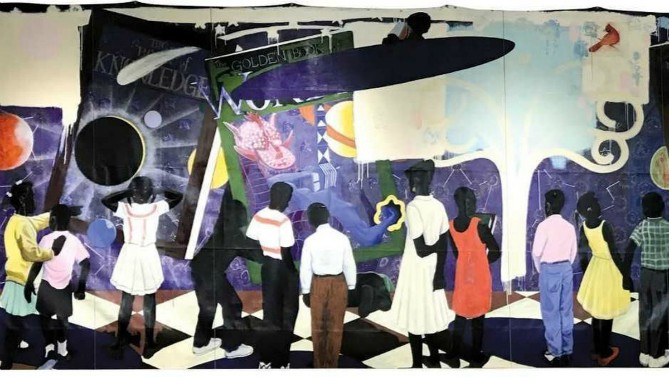By Ed McDevitt, Class of 2010
According to CPL‘s own history, after the Great Fire and the donation of 8,000 books by Queen Victoria and the English people, Illinois passed the Library Act of 1872 “which authorized cities to establish tax-supported libraries throughout the state.” (1) Previous libraries in Chicago and elsewhere had been private.

On January 1, 1873, the first Chicago Public Library opened at the southeast corner of LaSalle and Adams “in a circular water tank that survived the fire.” The Rookery sits on that site today.

The library moved again and again over the next 24 years, residing for 11 of those years on the fourth floor of City Hall.
On October 11, 1897 the Central Library, designed by A.H. Coolidge of Shepley, Rutan and Coolidge, opened on Michigan Avenue. It is now, of course, the Chicago Cultural Center. Over the next 125 years, the Chicago Public Library system has grown to 81 locations and includes the central library, two regional libraries, and 78 branch libraries. Let’s look at three examples of the library’s growth.
Blackstone Branch
The first branch library was constructed using funds provided by Isabella N. Blackstone, whose late husband Timothy had been president of Chicago and Alton Railroad. The Blackstone Branch, located at 4904 S. Lake Park Avenue, was designed by Solon S. Beman and modeled after the Erechtheion on the Acropolis in Athens. It opened in 1904 and continues to serve Hyde Park and Kenwood. It was named a Chicago Landmark in 2010. (2)
Henry E. Legler Branch/Regional Library
In 1916 “Chief Librarian Henry E. Legler… called for an extensive network of neighborhood library locations … to bring ‘library service within the walking distance of home for every person in Chicago who can read or wants to use books.’” (3) He also championed regional libraries to provide more robust library resources closer to home.
The first regional library was established in 1920 and named in his honor: the Henry E. Legler Regional Library. Located at 115 South Pulaski Road in the West Garfield Park neighborhood, it was designed in the Beaux Arts style by Alfred S. Alschuler.
The Legler is currently closed for renovations that will upgrade its infrastructure, programs and services, increase collections and technology, add community and study spaces, and make life safety and security enhancements. (3) When it reopens, the Legler will once again be a regional library for Chicago’s west side.
The building was awarded Chicago Landmark status in 1987 and listed in the National Register of Historic Places. (4)
Conrad Sulzer Regional Library
This 1985 building at 4455 North Lincoln Avenue in Ravenswood, a few blocks south of Lincoln Square, was designed by Hammond Beeby and Babka, the designers of the 1991 Harold Washington Library Center.
The neighborhood’s cultural roots are German-American. This post-modern building drew on inspiration from German neoclassical architecture.
According to the Chicago Public Library’s description of the building, “Chicago Public Library’s regional library for the North Side was named for Conrad Sulzer (1804-1873), who immigrated to Chicago from Switzerland and was one of the earliest known settlers of the Lake View community. . . . Sulzer contains 65,000 square feet and includes an auditorium accommodating 200 people, an expanded browsing area and a neighborhood historical room housing the Ravenswood-Lake View Community Collection.”
This regional library, the newest of the two in the system, is the repository of the Northside Neighborhood History Collection which includes the following photo collections (5):
- Esther A. Barlow Collection
- Family photographs of CPL Librarian Esther Barlow and images of her work at the former Hild Regional Library and Lake View Branch Library from 1927 to 1976.
- Henry D. Green Photograph Collection
- Photographs by Henry Green of businesses, community groups, neighborhood celebrations and school events on Chicago’s North Side, 1943-1951.
- Robert W. Krueger Photograph Collection
- Local photographer Robert Krueger documented Chicago’s North Side with photographs of community events, buildings, and people.
- Northside Clubs and Organizations
- Glimpse into the activities of the thriving civic service scene on the North Side as well as the rich ethnic and religious heritage of the community.
- Northside High Schools
- Photographs of high school football games, theatrical productions, dances and extracurricular activities from the 1870s to the 1950s.
- Ravenswood-Lake View Community Collection
- Street scenes and community life on the North Side, 1860s-1990s.
Chicago Public Libraries support each of our 77 official neighborhoods. You’re sure to drive by one as you traverse the city. Stop by for the architecture – then come in and browse.

Sources:
- https://www.chipublib.org/cpl-history/
- 2.(http://webapps1.chicago.gov/landmarksweb/web/landmarkdetails.htm?lanId=13065
- 3.(https://www.pbcchicago.com/projects/legler-branch-library-renovation
- https://www.chipublib.org/cpl-history/
- https://www.fhpaschen.com/paschen-renovates-historic-familiar-chicago-public-library/








Thanks, Ed. Always nice to hear about an institution that is so close to all of our hearts.
Very good article,, Ed! Thanks from a retired librarian.
Very interesting. Thanks
HI Ed,
Thanks for highlighting some great libraries in Chicago that I was not aware of. Great pictures.
Tom
Thanks for your research and pictures, Ed!
Very informative, Ed!